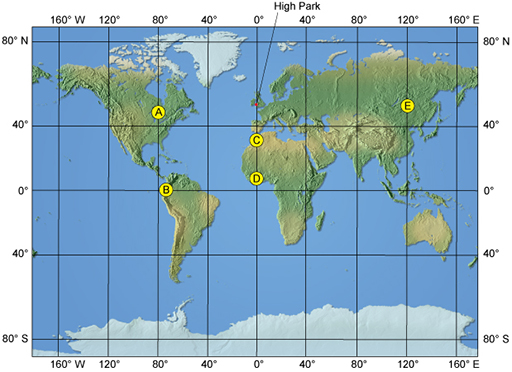2.3 The Earth
In the slide show below, the dimensions of the Earth and its trajectory around the Sun are given, together with the time it takes the Earth to spin on its axis and complete an orbit of the Sun. Using these data, you can consider the speed at which the Earth is moving. The way to describe a unique location on Earth is covered, along with the implications for life of the Earth’s motion over different timescales.
While working through the slides, record the following information to use in the questions that follow:
- the average radius of the Earth
- the average distance and duration of the Earth’s orbit around the Sun
- the time it takes for the Earth to spin once on its axis.
Question 1
What is the average circumference of the Earth? Use the value of the radius you recorded from the video and the following equation:
- circumference = 2 × π × r
where r is the radius and π has a value of 3.14.
Write your answer without spaces between consecutive digits, and don’t forget to consider significant figures.
Discussion
You may have wondered about what number of significant figures was appropriate for your answer. Let’s look at the data provided.
The radius was given to 4 significant figures and the value for π was given to three significant figures. However, the 2 might appear to have only 1 significant figure, but in fact it is a special case. It is an integer, and so is viewed as being infinitely precise – it isn’t something measured, it is an absolute value.
So, the least precise value here is π, so the answer should be quoted to the same precision, and so the answer is given as 40 000 km (to three significant figures). It is very important to quote the level of precision here as, without it, 40 000 km has an ambiguous number of significant figures. It could be understood to be an answer given to the precision of 1 significant figure or 5 significant figures, when actually the value is calculated to 3 significant figures.
Question 2
The circumference at the Equator is 40 030 km. (Remember the Earth is widest at the Equator so this value is slightly different from that given in Question 1.) Ignoring the fact that the Earth is travelling around the Sun, how fast would you be moving if you were standing at the Equator? (Note that speed is calculated as distance travelled over (divided by) time taken, and you’ll need to use the time it takes for the Earth to rotate once in your calculation.)
Give your answer to the nearest km h−1, remembering to quote your answer to the correct number of significant figures.
Question 3
When standing in the Equator, or indeed anywhere on Earth, you don’t feel as though you are moving at such high speeds as you have just calculated (or indeed any speed). The following is an explanation given by one of the physicists at The Open University. Use your developing knowledge of units, and rates, to complete the paragraph by selecting the correct options from the drop-down lists.
Discussion
There was a tricky conversion in this question, where 450 km h−2 was converted to 0.035 m s−2. Here’s some additional information about how this was done.
The value 450 km h−2 is a measure of acceleration (not speed), which indicates that the Earth has an acceleration of 450 km per hour, each hour. To convert km h−2 to m s−2 you first convert km to m (by multiplying by 1000), which gives
450 km h−2 × 1000 m km−1 = 450 000 m h−2
Then you need to convert hours into seconds, twice, because the acceleration is ‘m per hour per hour’. As there are 3600 seconds in an hour, you should divide by 3600, but because you are working with h−2, you need to do apply to conversion twice. Hence:
Notice how dividing by 3600 s h−1 × 3600 s h−1 results in the h−2 on the top cancelling with the h−1 × h−1 on the bottom.
As described in the slides, locations at the same latitude experience the same lengths of day. Locations at the same longitude are (generally) in the same time zone, but experience differences in day length across the year due to the tilt of the axis on which the Earth spins. you can compare two locations: High Park in England (51.84 °N, 1.4 °W), which is marked on Figure 1, and the city of Accra (5.6 °N, 0.2 °W).

Question 4
Question 5
To explore the variation in the time that locations have daylight, Table 4 below gives the sunrise and sunset times for two locations at the same longitude but different latitudes. Some of the values are missing (see X–Z). Select the correct daylight length times for these values from the options below.
High Park, United Kingdom Latitude: 51.84 °N |
Accra, Ghana Latitude: 5.6 °N |
|||||||
|---|---|---|---|---|---|---|---|---|
| Sunrise | Sunset | Daylight length/hours:min | Min–max temp/°C | Sunrise | Sunset | Daylight length/ hours: min | Min–max temp/°C | |
| Mar 20 | 6:00 | 18:15 | HighlightedW | 3.7–10.0 | 6:00 | 18:15 | 12:15 | 24.5–32.5 |
| Jun 20 | 4:45 | 21:30 | HighlightedX | 10.9–20.3 | 5:45 | 18:15 | 12:30 | 22.8–29.6 |
| Sep 20 | 6:45 | 19:00 | HighlightedY | 10.7–19.1 | 5:45 | 18:00 | 12:15 | 22.5–29.1 |
| Dec 20 | 8:15 | 15:45 | HighlightedZ | 2.3–7.7 | 6:00 | 18:00 | 12:00 | 22.5–31.6 |
Question 6
Using Table 4, describe the changes in day length over a year in both locations including how much that time changes over the year. How do these changes relate to variation in temperature? (You answer should be 100–150 words.)
Compare your answer to ours once you have completed it.
Answer
Day length at High Park varies from less than 8 hours in winter to more than 16 in summer. The number of daylight hours in summer is double that in winter (see June and December respectively). This is mirrored in big changes in temperature with nearly 10 °C differences between summer and winter.
In contrast in Accra, day length is between 12.25 and 12.5 hours all year around, varying by less than 15 minutes. Similarly, the maximum and minimum temperatures vary by less than 4 °C throughout the year.
There must be factors other than day length that determine temperature, because when day length is over 16 hours in the UK the temperature is still lower than for shorter days in Ghana.
Question 7
Consolidate your knowledge by considering how the environmental conditions resulting from the Earth’s properties relate to the biology of an oak. Complete the following paragraphs by selecting the correct options from the drop-down lists.
How the distance the Earth travels around the Sun compares to the other distance scales encountered has not yet been considered. The final question in this section will allow you to do that, and combine it with how long that orbit takes.
Question 8
Calculate the average trajectory distance of the Earth around the Sun in metres, and also the time this takes in seconds, then use these to add the bar ‘Earth’s orbit around the Sun’ bar to the size–time explorer [Tip: hold Ctrl and click a link to open it in a new tab. (Hide tip)] . (Remember that you can use the ‘Link to material’ icon to return to these questions once you’ve added your new bar to the explorer.)
Summary
In this section you considered how the rotation of the Earth and its orbit around the Sun affects the planet. Specific locations can be described with values of latitude and longitude. Using information from multiple scales in time and space you were able to consider how planetary motion relates to chemical reactions in leaves. Through calculations you considered how fast a point at the Equator moves as the Earth spins.
Next: Learn about galaxies or you can return to the size–time explorer and choose a level for yourself, or use the ‘Next >’ button to go to the next level down on the size scale.
